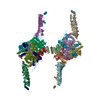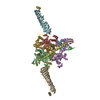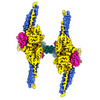+ データを開く
データを開く
- 基本情報
基本情報
| 登録情報 |  | |||||||||
|---|---|---|---|---|---|---|---|---|---|---|
| タイトル | Radial spoke head-neck dimer | |||||||||
 マップデータ マップデータ | RS head-neck dimer composite map | |||||||||
 試料 試料 |
| |||||||||
 キーワード キーワード | radial spoke / cilia / STRUCTURAL PROTEIN | |||||||||
| 機能・相同性 |  機能・相同性情報 機能・相同性情報maintenance of ciliary planar beating movement pattern / radial spoke head 1 / radial spoke head 2 / radial spoke head 3 / radial spoke assembly / radial spoke head / mating / axonemal central apparatus assembly / radial spoke / outer dense fiber ...maintenance of ciliary planar beating movement pattern / radial spoke head 1 / radial spoke head 2 / radial spoke head 3 / radial spoke assembly / radial spoke head / mating / axonemal central apparatus assembly / radial spoke / outer dense fiber / epithelial cilium movement involved in extracellular fluid movement / cilium movement involved in cell motility / sperm head-tail coupling apparatus / 9+2 motile cilium / axoneme assembly / cilium movement / kinocilium / ventricular system development / flagellated sperm motility / Set1C/COMPASS complex / UTP biosynthetic process / CTP biosynthetic process / meiotic spindle / nucleoside diphosphate kinase activity / motile cilium / GTP biosynthetic process / axoneme / cilium assembly / spermatid development / sperm flagellum / negative regulation of oxidative stress-induced intrinsic apoptotic signaling pathway / 3'-5' exonuclease activity / response to reactive oxygen species / condensed nuclear chromosome / meiotic cell cycle / establishment of localization in cell / unfolded protein binding / protein folding / 加水分解酵素; エステル加水分解酵素 / extracellular region / cytoplasm 類似検索 - 分子機能 | |||||||||
| 生物種 |  | |||||||||
| 手法 | 単粒子再構成法 / クライオ電子顕微鏡法 / 解像度: 3.57 Å | |||||||||
 データ登録者 データ登録者 | Meng X / Cong Y | |||||||||
| 資金援助 |  中国, 1件 中国, 1件
| |||||||||
 引用 引用 |  ジャーナル: Nat Commun / 年: 2024 ジャーナル: Nat Commun / 年: 2024タイトル: Multi-scale structures of the mammalian radial spoke and divergence of axonemal complexes in ependymal cilia. 著者: Xueming Meng / Cong Xu / Jiawei Li / Benhua Qiu / Jiajun Luo / Qin Hong / Yujie Tong / Chuyu Fang / Yanyan Feng / Rui Ma / Xiangyi Shi / Cheng Lin / Chen Pan / Xueliang Zhu / Xiumin Yan / Yao Cong /  要旨: Radial spokes (RS) transmit mechanochemical signals between the central pair (CP) and axonemal dynein arms to coordinate ciliary motility. Atomic-resolution structures of metazoan RS and structures ...Radial spokes (RS) transmit mechanochemical signals between the central pair (CP) and axonemal dynein arms to coordinate ciliary motility. Atomic-resolution structures of metazoan RS and structures of axonemal complexes in ependymal cilia, whose rhythmic beating drives the circulation of cerebrospinal fluid, however, remain obscure. Here, we present near-atomic resolution cryo-EM structures of mouse RS head-neck complex in both monomer and dimer forms and reveal the intrinsic flexibility of the dimer. We also map the genetic mutations related to primary ciliary dyskinesia and asthenospermia on the head-neck complex. Moreover, we present the cryo-ET and sub-tomogram averaging map of mouse ependymal cilia and build the models for RS1-3, IDAs, and N-DRC. Contrary to the conserved RS structure, our cryo-ET map reveals the lack of IDA-b/c/e and the absence of Tektin filaments within the A-tubule of doublet microtubules in ependymal cilia compared with mammalian respiratory cilia and sperm flagella, further exemplifying the structural diversity of mammalian motile cilia. Our findings shed light on the stepwise mammalian RS assembly mechanism, the coordinated rigid and elastic RS-CP interaction modes beneficial for the regulation of asymmetric ciliary beating, and also facilitate understanding on the etiology of ciliary dyskinesia-related ciliopathies and on the ependymal cilia in the development of hydrocephalus. | |||||||||
| 履歴 |
|
- 構造の表示
構造の表示
| 添付画像 |
|---|
- ダウンロードとリンク
ダウンロードとリンク
-EMDBアーカイブ
| マップデータ |  emd_38020.map.gz emd_38020.map.gz | 41.1 MB |  EMDBマップデータ形式 EMDBマップデータ形式 | |
|---|---|---|---|---|
| ヘッダ (付随情報) |  emd-38020-v30.xml emd-38020-v30.xml emd-38020.xml emd-38020.xml | 18.7 KB 18.7 KB | 表示 表示 |  EMDBヘッダ EMDBヘッダ |
| 画像 |  emd_38020.png emd_38020.png | 98.7 KB | ||
| Filedesc metadata |  emd-38020.cif.gz emd-38020.cif.gz | 7 KB | ||
| アーカイブディレクトリ |  http://ftp.pdbj.org/pub/emdb/structures/EMD-38020 http://ftp.pdbj.org/pub/emdb/structures/EMD-38020 ftp://ftp.pdbj.org/pub/emdb/structures/EMD-38020 ftp://ftp.pdbj.org/pub/emdb/structures/EMD-38020 | HTTPS FTP |
-検証レポート
| 文書・要旨 |  emd_38020_validation.pdf.gz emd_38020_validation.pdf.gz | 331.3 KB | 表示 |  EMDB検証レポート EMDB検証レポート |
|---|---|---|---|---|
| 文書・詳細版 |  emd_38020_full_validation.pdf.gz emd_38020_full_validation.pdf.gz | 330.9 KB | 表示 | |
| XML形式データ |  emd_38020_validation.xml.gz emd_38020_validation.xml.gz | 7.8 KB | 表示 | |
| CIF形式データ |  emd_38020_validation.cif.gz emd_38020_validation.cif.gz | 9.1 KB | 表示 | |
| アーカイブディレクトリ |  https://ftp.pdbj.org/pub/emdb/validation_reports/EMD-38020 https://ftp.pdbj.org/pub/emdb/validation_reports/EMD-38020 ftp://ftp.pdbj.org/pub/emdb/validation_reports/EMD-38020 ftp://ftp.pdbj.org/pub/emdb/validation_reports/EMD-38020 | HTTPS FTP |
-関連構造データ
| 関連構造データ |  8x2uMC  8wzbC C: 同じ文献を引用 ( M: このマップから作成された原子モデル |
|---|---|
| 類似構造データ | 類似検索 - 機能・相同性  F&H 検索 F&H 検索 |
- リンク
リンク
| EMDBのページ |  EMDB (EBI/PDBe) / EMDB (EBI/PDBe) /  EMDataResource EMDataResource |
|---|---|
| 「今月の分子」の関連する項目 |
- マップ
マップ
| ファイル |  ダウンロード / ファイル: emd_38020.map.gz / 形式: CCP4 / 大きさ: 669.9 MB / タイプ: IMAGE STORED AS FLOATING POINT NUMBER (4 BYTES) ダウンロード / ファイル: emd_38020.map.gz / 形式: CCP4 / 大きさ: 669.9 MB / タイプ: IMAGE STORED AS FLOATING POINT NUMBER (4 BYTES) | ||||||||||||||||||||||||||||||||||||
|---|---|---|---|---|---|---|---|---|---|---|---|---|---|---|---|---|---|---|---|---|---|---|---|---|---|---|---|---|---|---|---|---|---|---|---|---|---|
| 注釈 | RS head-neck dimer composite map | ||||||||||||||||||||||||||||||||||||
| 投影像・断面図 | 画像のコントロール
画像は Spider により作成 | ||||||||||||||||||||||||||||||||||||
| ボクセルのサイズ | X=Y=Z: 0.854 Å | ||||||||||||||||||||||||||||||||||||
| 密度 |
| ||||||||||||||||||||||||||||||||||||
| 対称性 | 空間群: 1 | ||||||||||||||||||||||||||||||||||||
| 詳細 | EMDB XML:
|
-添付データ
- 試料の構成要素
試料の構成要素
-全体 : Radial spoke head-neck dimer
| 全体 | 名称: Radial spoke head-neck dimer |
|---|---|
| 要素 |
|
-超分子 #1: Radial spoke head-neck dimer
| 超分子 | 名称: Radial spoke head-neck dimer / タイプ: complex / ID: 1 / 親要素: 0 / 含まれる分子: all |
|---|---|
| 由来(天然) | 生物種:  |
-分子 #1: DPY30 domain containing 2
| 分子 | 名称: DPY30 domain containing 2 / タイプ: protein_or_peptide / ID: 1 / コピー数: 2 / 光学異性体: LEVO |
|---|---|
| 由来(天然) | 生物種:  |
| 分子量 | 理論値: 18.235326 KDa |
| 組換発現 | 生物種:  Homo sapiens (ヒト) Homo sapiens (ヒト) |
| 配列 | 文字列: MYPYDVPDYA ENLYFQGAAA MDTAYLKNCF GTGLTQALAE VARVRPSDPI EYLAHWLYHY RSITVAEEKR RQEELQLKEA RDRSAEEAK TTEMLKEEGY QIQQKCEKCH QELPSTSFSS DKTPALQEDT APLEEKTMRQ ESQPGASRVI SEMPQRAIPS UniProtKB: DPY30 domain containing 2 |
-分子 #2: DnaJ homolog subfamily B member 13
| 分子 | 名称: DnaJ homolog subfamily B member 13 / タイプ: protein_or_peptide / ID: 2 / コピー数: 2 / 光学異性体: LEVO |
|---|---|
| 由来(天然) | 生物種:  |
| 分子量 | 理論値: 40.119445 KDa |
| 組換発現 | 生物種:  Homo sapiens (ヒト) Homo sapiens (ヒト) |
| 配列 | 文字列: MDYKDHDGDY KDHDIDYKDD DDKENLYFQG AAAMGLDYYA VLQVTRNSED AQIKKAYRKL ALKNHPLKSS EPGAPEIFKQ IAEAYDVLS DPVKRGIYDK FGEEGLKGGI PLEFGSQTPW TTGYVFHGNP DKVFHEFFGG DNPFSEFFDA EGNDIDLNFG G LWGRGVQK ...文字列: MDYKDHDGDY KDHDIDYKDD DDKENLYFQG AAAMGLDYYA VLQVTRNSED AQIKKAYRKL ALKNHPLKSS EPGAPEIFKQ IAEAYDVLS DPVKRGIYDK FGEEGLKGGI PLEFGSQTPW TTGYVFHGNP DKVFHEFFGG DNPFSEFFDA EGNDIDLNFG G LWGRGVQK QDPPIERDLY LSLEDLFFGC TKKIKISRRV LNEDRYSSTI KDKILTIDVR PGWRQGTRIT FEKEGDQGPN II PADIIFI VKEKLHPRFR REHDNLFFVY PIPLGKALTC CTVEVKTLDD RLLNIPINDI VHPKYFKIVP GEGMPLPENP SKK GDLFIF FDIQFPTRLT PQKKQMLRQA LLT UniProtKB: DnaJ homolog subfamily B member 13 |
-分子 #3: Radial spoke head protein 3 homolog B
| 分子 | 名称: Radial spoke head protein 3 homolog B / タイプ: protein_or_peptide / ID: 3 / コピー数: 2 / 光学異性体: LEVO |
|---|---|
| 由来(天然) | 生物種:  |
| 分子量 | 理論値: 45.23427 KDa |
| 組換発現 | 生物種:  Homo sapiens (ヒト) Homo sapiens (ヒト) |
| 配列 | 文字列: MTDRNPRTAE ASGLYTYSSR PRAVACQRRR HRDSILQPVE EPMSYGNIMY DRRVIRGNTY ALPTGQVPGQ PDPLELQRQQ QARRRALAR KRAQEQLKPR TPEPVEGRKH VDIQTELYLE EIADRIVEVD MECQTDAFLD RPPTPLFIPA KTGKDVATQI L GGELFDFD ...文字列: MTDRNPRTAE ASGLYTYSSR PRAVACQRRR HRDSILQPVE EPMSYGNIMY DRRVIRGNTY ALPTGQVPGQ PDPLELQRQQ QARRRALAR KRAQEQLKPR TPEPVEGRKH VDIQTELYLE EIADRIVEVD MECQTDAFLD RPPTPLFIPA KTGKDVATQI L GGELFDFD LEVKPMLEVL VGKTIEQSLL EVMEEEELAN LRARQYAYEE IRNVELAEVQ RLEEQERRHR EEKERRKKQQ WE IVHKRNE TLQKISALIF ARQYLANLLP SVFDKLRNSG FFYDPIERDI EVGFLPWLMN EVEKSMEHSM VGRTVLDMLI RDV VERRIN DYEHKEAMPP GQKTNVINGP NTVTDPSVTT LHTQKPVLDR VSSQPAPSQE RKPVEEGGHL MAE UniProtKB: Radial spoke head protein 3 homolog B |
-分子 #4: Nucleoside diphosphate kinase homolog 5
| 分子 | 名称: Nucleoside diphosphate kinase homolog 5 / タイプ: protein_or_peptide / ID: 4 / コピー数: 2 / 光学異性体: LEVO |
|---|---|
| 由来(天然) | 生物種:  |
| 分子量 | 理論値: 25.547516 KDa |
| 組換発現 | 生物種:  Homo sapiens (ヒト) Homo sapiens (ヒト) |
| 配列 | 文字列: MEQKLISEED LGSGMEVSMP LPQIYVEKTL ALIKPDVVDK EEEIQDIILG SGFTIIQRRK LHLSPEHCSN FYVEQYGKMF FPNLTAYMS SGPLVAMILA RHKAISYWKE LMGPSNSLVA KETHPDSLRA IYGTDELRNA LHGSNDFAAS EREIRFMFPA V IIEPIPIG ...文字列: MEQKLISEED LGSGMEVSMP LPQIYVEKTL ALIKPDVVDK EEEIQDIILG SGFTIIQRRK LHLSPEHCSN FYVEQYGKMF FPNLTAYMS SGPLVAMILA RHKAISYWKE LMGPSNSLVA KETHPDSLRA IYGTDELRNA LHGSNDFAAS EREIRFMFPA V IIEPIPIG QAAKDYINLY VAPTLLQGLT ELCKEKPPDP YLWLADWLMK NNPNKPKLCH FPVTEEP UniProtKB: Nucleoside diphosphate kinase homolog 5 |
-分子 #5: Radial spoke head 1 homolog
| 分子 | 名称: Radial spoke head 1 homolog / タイプ: protein_or_peptide / ID: 5 / コピー数: 4 / 光学異性体: LEVO |
|---|---|
| 由来(天然) | 生物種:  |
| 分子量 | 理論値: 35.592766 KDa |
| 組換発現 | 生物種:  Homo sapiens (ヒト) Homo sapiens (ヒト) |
| 配列 | 文字列: MWSHPQFEKG SGMSDLGSEE LEEEGENDLG EYEGERNEVG ERHGHGKARL PNGDTYEGSY EFGKRHGQGT YKFKNGARYT GDYVKNKKH GQGTFIYPDG SRYEGEWADD QRHGQGVYYY VNNDTYTGEW FNHQRHGQGT YLYAETGSKY VGTWVHGQQE G AAELIHLN ...文字列: MWSHPQFEKG SGMSDLGSEE LEEEGENDLG EYEGERNEVG ERHGHGKARL PNGDTYEGSY EFGKRHGQGT YKFKNGARYT GDYVKNKKH GQGTFIYPDG SRYEGEWADD QRHGQGVYYY VNNDTYTGEW FNHQRHGQGT YLYAETGSKY VGTWVHGQQE G AAELIHLN HRYQGKFMNK NPVGPGKYVF DIGCEQHGEY RLTDTERGEE EEEEETLVNI VPKWKALNIT ELALWTPTLS EE QPPPEGQ GQEEPQGLTG VGDPSEDIQA EGFEGELEPR GADEDVDTFR QESQENSYDI DQGNLNFDEE PSDLQD UniProtKB: Radial spoke head 1 homolog |
-分子 #6: Radial spoke head protein 4 homolog A
| 分子 | 名称: Radial spoke head protein 4 homolog A / タイプ: protein_or_peptide / ID: 6 / コピー数: 4 / 光学異性体: LEVO |
|---|---|
| 由来(天然) | 生物種:  |
| 分子量 | 理論値: 80.214102 KDa |
| 組換発現 | 生物種:  Homo sapiens (ヒト) Homo sapiens (ヒト) |
| 配列 | 文字列: MENSTSLKQE KENQEPGEAE RLWQGESDVS PQEPGPPSPE YREEEQRTDT EPAPRMSPSW SHQSRVSLST GDLTAGPEVS SSPPPPPLQ FHSTPLNTET TQDPVAASPT EKTANGIADT GTPYSDPWES SSAAKQSTSH YTSHAEESTF PQSQTPQPDL C GLRDASRN ...文字列: MENSTSLKQE KENQEPGEAE RLWQGESDVS PQEPGPPSPE YREEEQRTDT EPAPRMSPSW SHQSRVSLST GDLTAGPEVS SSPPPPPLQ FHSTPLNTET TQDPVAASPT EKTANGIADT GTPYSDPWES SSAAKQSTSH YTSHAEESTF PQSQTPQPDL C GLRDASRN KSKHKGLRFD LLQEEGSDSN CDPDQPEVGA SEAAQSMLEV AIQNAKAYLL STSSKSGLNL YDHLSKVLTK IL DERPADA VDIIENISQD VKMAHFNKKL DTLHNEYEML PAYEIAETQK ALFLQGHLEG ADSELEEEMA ESSLPNVMES AYY FEQAGV GLGTDETYRV FLALKQLTDT HPIQRCRFWG KILGLEMNYI VAEVEFRDGE DEEEVEEEGI AEERDNGGSE AGEE EEEEL PKSLYKAPQV IPKEESRTGA NKYVYFVCNV PGRPWVRLPS VTPAQIVTAR KIKKFFTGRL DAAVISYPPF PGNES NYLR AQIARISAGT HVSPLGFYQF GEEEGEEEEV EGGRDSYEEN PDFEGIQVID LVESLSNWVH HVQYILPQGR CNWFNP IQK DEDEEEEEEE DEEKGEEPDY IEQEVGPPLL TPISEDLGIQ NIPSWTTQLS SNLIPQYAIA VLRSNLWPGA YAFSNGK KF ENFYIGWGHK YCVENYTPPS PPPVYQEYPS GPEITEMNDP SVEEEQAFRM TQEPVALSTE ENEGTEDEDE DDED UniProtKB: Radial spoke head protein 4 homolog A |
-分子 #7: Radial spoke head protein 9 homolog
| 分子 | 名称: Radial spoke head protein 9 homolog / タイプ: protein_or_peptide / ID: 7 / コピー数: 4 / 光学異性体: LEVO |
|---|---|
| 由来(天然) | 生物種:  |
| 分子量 | 理論値: 31.365902 KDa |
| 組換発現 | 生物種:  Homo sapiens (ヒト) Homo sapiens (ヒト) |
| 配列 | 文字列: MDADSLLLSL ELASGSGQGL SPDRRASLLT SLMLVKRDYR FARVLFWGRI LGLVADYYIA QGLSEDQLAP RKTLYSLNCT EWSLLPPAT EEMAMQISVV SGRFMGDPSH EYEHTELQKV NEGEKVFDEE VVVQIKEETR LVSIIDQIDK AVAIIPRGAL F KTPFGVTH ...文字列: MDADSLLLSL ELASGSGQGL SPDRRASLLT SLMLVKRDYR FARVLFWGRI LGLVADYYIA QGLSEDQLAP RKTLYSLNCT EWSLLPPAT EEMAMQISVV SGRFMGDPSH EYEHTELQKV NEGEKVFDEE VVVQIKEETR LVSIIDQIDK AVAIIPRGAL F KTPFGVTH VNRTFEGLPL SEVRKLSSYF HFREAIDLKN KTLLEKSDLE PSLDFLDSLE YDIPRGSWSI QMERGNALVV LR SLLWPGL TFYHAPRTKN YGYIYVGTGE KNMDLPFML UniProtKB: Radial spoke head protein 9 homolog |
-実験情報
-構造解析
| 手法 | クライオ電子顕微鏡法 |
|---|---|
 解析 解析 | 単粒子再構成法 |
| 試料の集合状態 | particle |
- 試料調製
試料調製
| 緩衝液 | pH: 7.5 |
|---|---|
| 凍結 | 凍結剤: ETHANE |
- 電子顕微鏡法
電子顕微鏡法
| 顕微鏡 | FEI TITAN KRIOS |
|---|---|
| 撮影 | フィルム・検出器のモデル: GATAN K3 (6k x 4k) / 平均電子線量: 54.0 e/Å2 |
| 電子線 | 加速電圧: 300 kV / 電子線源:  FIELD EMISSION GUN FIELD EMISSION GUN |
| 電子光学系 | 照射モード: FLOOD BEAM / 撮影モード: BRIGHT FIELD / 最大 デフォーカス(公称値): 2.7 µm / 最小 デフォーカス(公称値): 1.0 µm |
| 実験機器 |  モデル: Titan Krios / 画像提供: FEI Company |
- 画像解析
画像解析
| 初期モデル | モデルのタイプ: NONE |
|---|---|
| 最終 再構成 | 解像度のタイプ: BY AUTHOR / 解像度: 3.57 Å / 解像度の算出法: FSC 0.143 CUT-OFF / 使用した粒子像数: 338084 |
| 初期 角度割当 | タイプ: MAXIMUM LIKELIHOOD |
| 最終 角度割当 | タイプ: MAXIMUM LIKELIHOOD |
 ムービー
ムービー コントローラー
コントローラー
























 Z (Sec.)
Z (Sec.) Y (Row.)
Y (Row.) X (Col.)
X (Col.)




















